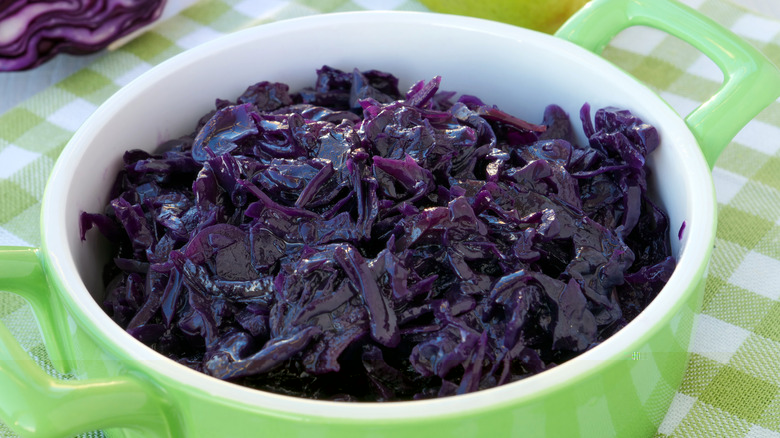What Exactly Is Blue Cabbage?
Blue is actually rather rare in nature — sea and sky aside — per Live Science. Take a look around on land and you're unlikely to find the color in the terrain or on animals or plants. Surprisingly, cabbage provides a rare exception... in certain cases.
Cabbage is a broad category of vegetables belonging to the mustard family, according to the Encyclopedia Britannica. When one says "cabbage," they usually mean head cabbage, the default kind that's so commonly eaten. However, this plant species also includes cultivated varieties like broccoli, collards, and kale. Cabbage is high in vitamin C yet low in calories, which is useful if you're looking to eat healthy. Folks have been taking advantage of that fact for a while now. Cabbage grows well in cool climates, so it's long been farmed in regions like Europe, dating back to Medieval times.
This leafy, culinary tradition continues to today. As explained by BBC Good Food, the wide variety of cabbages means at least some type of cabbage is always in season, with the best ones looking bright and crisp on the shelf. The different types range from sweet to savory in flavor, making cabbage a versatile ingredient. Cooks keep cabbages in cold, dim locations, then de-leaf, rinse, and cut them up before boiling, frying, or steaming the veggie. So, how does the blue form of cabbage factor into all of this?
Pigments make some produce bluish
Picture cabbage, and it probably appears green in your mind's eye. As noted by Britannica and BBC, cabbage usually grows to be viridescent, with tinges of gray or blue, but red and white are also possible. So, cabbage might naturally have hues of blue, but if you're looking for true-blue cabbage heads at the supermarket, you'll probably end up feeling a bit disappointed (or blue).
As Almanac explains, there's a whole lot of chemistry behind the general lack of all-blue foods. Plants get their color from pigments. Anthocyanins provide red and purple. Carotenoids provide yellow, orange, and red. Chlorophyll provides green, of course. Carotenoids and chlorophyll also provide some blue, but that tends to get lost in the mix, since blue pigments are often less stable than others and thus easily washed out. Sometimes, you do get blue produce like Concord grapes, but usually, it takes some extra chemistry to turn fruits and veggies blue.
And as it turns out, that sort of chemistry can be applied to cabbage.
Sautée red cabbage to make it blue
How does this work? According to the Splendid Table, some of the compounds found in produce are sensitive to acidity and turn red when exposed to it. So, if you have red cabbage, you can eliminate the redness and leave blue in its wake by making those red compounds nonacidic. In order to do this, you simply have to sauté it, which causes the acids to evaporate away. The result: blue cabbage!
The fact that cabbage must first be red and then sautéed in order to turn blue explains why it's not very common, especially not for sale. We can't imagine there's a terribly large market for pre-cooked cabbage. Still, if you do want to try blue cabbage, there are a few recipes out there you can use. Martha Stewart has a sweet-and-sour recipe for thinly sliced red cabbage sautéed with red-wine vinegar, then finished with light-brown sugar. Food & Wine adds bacon (or roasted fish filet if you prefer) to its sautéed red cabbage recipe. Last but not least, Food Network lists a Blaukraut recipe (a German word that translates to "red cabbage," per Cambridge Dictionary) that also sautés its red cabbage. Since they all use red cabbage and then sauté it, you'll produce blue cabbage if you make any of these. Not only will you end up with a meal, but you'll also have the pleasure of conducting a colorful experiment in the process!


